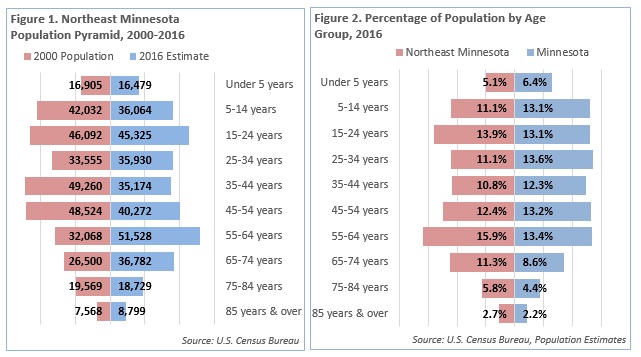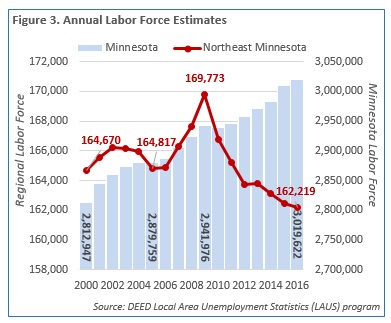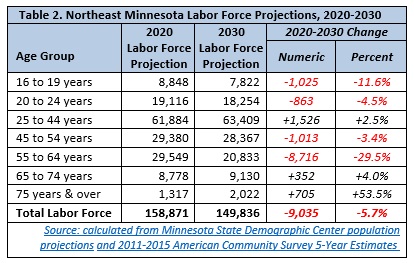 Home to the state's second-largest metro, the Northeast Region has a strong industrial sector, tied largely to the area's abundant natural resources.
Home to the state's second-largest metro, the Northeast Region has a strong industrial sector, tied largely to the area's abundant natural resources.
Most of the manufacturing base centers on mining and forest products industries. More than half of the sector's employment is in paper and machinery manufacturing.
Want the freshest data delivered by email? Subscribe to our regional newsletters.
8/14/2017 12:04:56 PM
Erik White
To highlight the updated 2017 Regional Profile, this month's blog post will focus on Northeast Minnesota's stable and aging population, and its impact on the regional economy.
An important, if not worrisome, aspect of Northeast Minnesota's population is that it has remained relatively stable over the past 16 years. Census data show that the Northeast has grown by 3,009 people since 2000, a 0.9 percent increase; all other regions, with the exception of Southwest Minnesota, have increased population by at least 30,000 people. The state of Minnesota gained 600,473 residents since 2000, with Northeast Minnesota contributing very little to the overall gains in population (Table 1). In addition, Northeast Minnesota saw a decrease of 721 people in the past year, dropping from 325,803 people in 2015.

While the total number of people living in the region has not changed much over time, the population continues to grow older. Since 2000, the number of people aged 55 years and older – which includes the baby boom generation, people who were born between 1946 and 1964 – increased by 30,133 people, a 35.2 percent jump. With 115,838 people aged 55 years or older, this age cohort now represents 35.7 percent of the total population in Northeast Minnesota, compared to just 28.6 percent of the overall state's population (Figures 1 and 2).

Population and its growth are important factors for regional economic success, and a stable and aging population in Northeast Minnesota should be a cause for concern, especially considering the decrease in labor force the region has already experienced since 2009. In the depths of the recession, Northeast Minnesota's labor force reached its peak with nearly 170,000 available workers, but by 2016 the region had only 162,219 workers, a 4.4 percent reduction to the overall workforce. Simultaneously, the state of Minnesota increased its workforce by 2.6 percent and gained nearly 80,000 workers since the recession (Figure 3).

If Northeast Minnesota's population grows at the rate projected by the Minnesota State Demographic Center and current labor force participation rates by age group remain unchanged, the region's labor force is expected to continue to decrease significantly. Projections show that Northeast Minnesota would lose about 9,000 workers by 2030, a 5.7 percent decrease from the projected labor force in 2020, adding to the expected loss of 3,500 workers from 2016 to 2020 (Table 2).

Without an increase to the population in the region and/or increasing labor force participation rates across all age groups, the shrinking supply of workers will remain a challenge for businesses. The continuing decrease of the labor force, caused by an aging and not increasing population, will likely continue to cause tight labor market conditions, forcing employers to respond to changing labor force availability.
Contact Erik White at erik.white@state.mn.us or 218-302-8413.